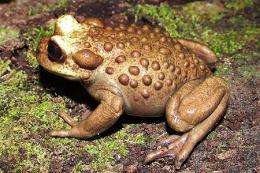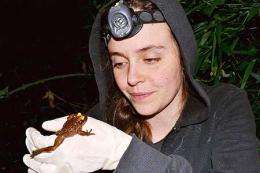Chilean biologist saving forests with frogs

(Phys.org)—Chilean biologist Virginia Moreno is besotted with frogs. So much so that she is taking on the might of the forestry industry to study one frog in particular – Chile's critically endangered mountain frog, Telmatobufo bullock.
She is one of the few to have seen T.bullocki – also known as the Nahuelbuta mountain frog – in recent years. The sighting, during a trip to Chile last year, had a fairy tale touch; "When I found the frog, he looked at me as if to say 'this is your destiny – here's your PhD'."
"Nobody had seen one for about ten years. Some people thought they were extinct, or close to extinction," says the young conservationist for whom the frogs are a focal point for the bigger picture of native forest and endemic species conservation in Chile.
Moreno, one of three recipients of the University's inaugural Sir Neil Waters scholarships awarded in September, returned to Chile last month for a second round of field work in the coastal Chilean mountain range to find the eight centimetre-long brownish frog with yellow eyelids and a distinctively knobbled back.
Her frog passion began with a Masters study of New Zealand native Hochstetter's frog, at Massey's Institute of Natural Sciences in Albany. Although in decline, Hochstetter's is our most common frog, found in the upper half of the North Island and on Great Barrier Island.
One legacy of her research is a monitoring scheme in the nearby Waitakere Ranges to check population changes, as well as for the presence of an introduced chytrid fungus that has decimated frog species overseas.
Her discovery of a T.bullocki, during an expedition with colleagues who had already found tadpoles of the species, sparked interest among scientists and media.

It also led her to finding three more populations in areas where native forest has been reduced to fragments amid larger commercial pine and eucalyptus forest plantations. Much of the region was cleared of forest 100 years ago to make way for cattle farming until the 1970s when government subsidies encouraged mass pine plantings. This left small fragments of native forest still home to a number of endemic species, including Darwin's fox, native deer, puma and black woodpecker.
For her PhD, she is surveying the frog populations to find out more about their abundance, habitat, their movements between forest and streams, and their breeding habits.
T.bullocki breed in fast-flowing streams. Tadpoles attach themselves to rocks with specially adapted suction mouths to feed on algae until they metamorphose and return to the forest. What concerns Moreno is not just the impact of the loss of native forest habitat, but the degradation of stream water they depend on for survival.
"Stream water gets polluted by silt from pines when it rains. Frogs can't get algae and feed when this happens. Then there are the pesticides and fertilisers in the water too," she says.
Her scientist's determination to find out more about the status and health of the frogs is tempered by a realist's appreciation of the need to balance environmental and economic issues. To that end, she's been negotiating with Chile's largest forestry company to postpone their scheduled harvest this year of a pine plantation where she found one of the frog populations.
"I'm working in collaboration with them," says Moreno. "It's easy to be a conservationist and say 'no, no – we don't want pines'. But it's not the reality. You have to accept economic factors. So if I want to make a difference, I really need to work with them, and not against them."
Using transmitters and radio tracking devices to track the frogs' movements, she aims to figure out the feasibility of translocating frogs from a soon-to-be-chopped pine area to a protected native forest patch and stream with a buffer zone.
In her favour is consumer demand for companies to comply with conservation regulations to retain a Forest Stewardship Certificate – critical to their reputation as being environmentally responsible.
As a top scholar with an eye on broader ecological issues she has had research support from the European Association of Zoos and Aquaria Amphibian Conservation Fund and the Mohamed bin Zayed Species Conservation Fund, has received a research award from the New Zealand Society for Research on Amphibians, and is currently funded by a PhD scholarship from the Chilean government.
Moreno came to New Zealand in 2007 with her boyfriend who is doing postdoctoral study on sustainability education at Waikato University. A Google search led her to Associate Professor Dianne Brunton's Ecology and Conservation Group at the Albany campus. Doing her Masters, she was struck by New Zealand's environmentally-aware culture.
By contrast her fellow Chileans are just starting to become attuned to environmental issues. Moreno used to enjoy her spare time fleeing the bustle and noise of Santiago for the wild beauty of Chile's national parks. Most people have not had the means to do this. But that's changing. She has noticed more locals – not just tourists – visiting parks and experiencing the natural world first hand, something she believes is the key to conservation.
"Once you experience nature, you can't do anything else but love it. And once you love it, you start to care about it."
Provided by Massey University


















